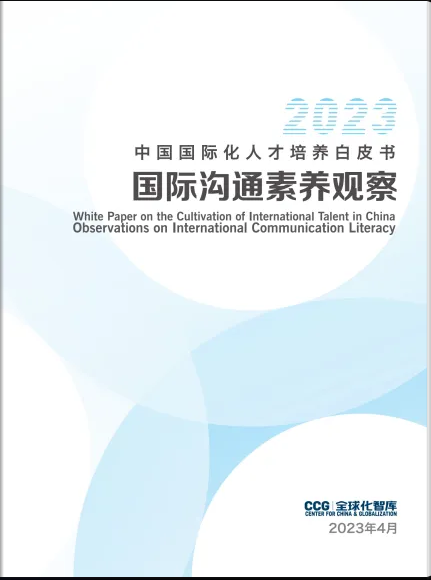CCG Report: White Paper on the Cultivation of International Talent in China

White Paper on the Cultivation of International Talent in China
Observations on International Communication Literacy
Key Finding
1. Based on research and analysis, this report has constructed a framework for the international communication literacy of international talent, including three levels: emotional core, cognitive basis, and behavioral elements. The emotional core is the foundation and prerequisite of international communication literacy, including two important elements: national identity and global concern. The cognitive basis is the bridge connecting the emotional core and behavioral elements, including foreign language knowledge and skills, world knowledge and global issues, professional knowledge and skills, and information technology knowledge and skills. Behavioral elements are the external manifestations of the emotional core and cognitive basis, which can promote the formation of the emotional core and cognitive basis, including two forms: deep understanding and effective expression.
2. International communication literacy cultivating, represented by foreign language knowledge and skills, has achieved rich results. Currently, international communication literacy cultivating has run through the whole process of basic, secondary, and higher education and vocational education system, and expanded into various disciplinary fields of education from the English education field. International schools continue to develop in the basic education stage. As of October 2020, there are a total of 1,399 full-time international schools nationwide operating routinely, adopting international curricula and implementing bilingual teaching. More and more universities are creating international campus environments and enhancing their internationalization level. Among the top 100 Chinese mainland universities in QS ranking, the proportion of international students is 5.4%~17.5%, and the proportion of international faculty staff is 6%~47%. Since 2009, China has become the country with the most TOEFL test takers in the world. From the “TOEFL iBT Test and Score Data Summary” released by ETS every year, the average score of Chinese test takers in the TOEFL test has significantly improved in the past decade, from 77 in 2010 to 87 in 2021, gradually approaching the global average score (88); the proportion of test takers with a TOEFL score above 100 has tripled compared to 2009.
3. Going abroad to study is an indispensable step to improve international communication literacy and cultivate international talent. Currently, China has carried out educational cooperation and exchanges with 181 countries with diplomatic relations; and signed degree recognition agreements with 58 countries and regions, providing Chinese students with rich and colorful opportunities to study abroad. According to UNESCO’s data, in 2021, the number of outbound students in higher education institutions from the Chinese mainland was 1.088 million. In addition to customary study destinations such as the United States, the United Kingdom, Australia, Canada, South Korea, Germany, France, Italy, Ireland, and other European countries as well as ASEAN countries such as Malaysia and Thailand have become important destinations. Since 2008, China has been the largest source of international students in the United States for 15 consecutive years. In the academic year 2021~2022, the number of Chinese international students still ranked first in the number of international students, with about 290,000 people, accounting for 30.6% of the international students in higher education institutions in American.
4. China’s preliminary development mode for cultivating international communication literacy is led by the developed regions in the East. The internationalization level of the developed provinces and cities in the east is relatively high, with a more diverse and open atmosphere and a richer international culture. They have more international education resources, such as international schools, and place a high value on international communication literacy. Their international communication literacy is higher than that of other regions. In 2021, the average TOEFL score for Chinese test takers was 87 points. Among the 31 provinces, autonomous regions, and municipalities (excluding Hong Kong, Macao, and Taiwan), 24 provinces and cities had an average TOEFL score of over 80 points. The number of Chinese TOEFL test takers and their score distribution also shows significant regional differences, with a 15-point difference in average scores between provinces.
5. International communication literacy mainly includes the behavioral elements of “deep understanding” and “effective expression”. This report uses the “listening and reading” section of the TOEFL exam and the “verbal reasoning” section of the GRE exam as indicators of deep understanding, and the “speaking and writing” section of the TOEFL exam and the “analytical writing” section of the GRE exam as indicators of effective expression. The report analyzes the development status of international communication literacy among China’s international talents, and finds that:
(1) Chinese test takers’ deep understanding indicators are close to or exceed the global average level. The average reading comprehension score of Chinese TOEFL test takers exceeds the global average, and their listening comprehension score has steadily improved and is approaching the global average. Since 2008, Chinese TOEFL test takers’ reading scores have started to surpass the global average. In 2021, their reading score (23 points) was one point higher than the global average. Chinese TOEFL test takers’ listening scores have steadily improved, further narrowing the gap with the global average. In 2021, the difference between their listening score (22 points) and the global average (23 points) was reduced to 1 point. Meanwhile, the verbal reasoning score of Chinese GRE test takers (152.3 points) surpassed the global average (151.4 points) in 2020.
(2) The gap between Chinese test takers’ effective expression indicators and the global average level has gradually narrowed. From 2008 to 2021, the gap between Chinese TOEFL test takers’ writing scores and the global average has gradually decreased and reached the global average score in 2021. The difference between Chinese TOEFL test takers’ speaking scores and the global average has been steadily decreasing, and as of 2021, the difference between the two is only 1 point. At the same time, the gap between the analytical writing score of Chinese GRE test takers and the global average has gradually narrowed. In the academic year of 2011~2012, Chinese test takers’ analytical writing score was 0.6 points lower than the global score. For the following six years, the gap remained at around 0.5 points. In 2020, the gap between the analytical writing score of Chinese test takers (3.3 points) and the global average score was reduced to 0.3 points.
6. To further promote the development of international human resources in China, the following suggestions are proposed in this report:
(1) Studying abroad is still the main channel for people to enhance their international communication skills and become international talent. International students play important roles in promoting economic development and international cultural exchanges. In the complex international situation, it is necessary to continue to strengthen stable educational exchange and cooperation with developed countries such as the United States, Germany, the United Kingdom, and partner countries of the “Belt and Road” initiative. China should continue to encourage its students to study abroad in these countries and welcome outstanding students from these countries to study in China, and increase the efforts in developing international human resources in China.
(2) From different perspectives of promoting national development, enhancing national literacy, promoting enterprise globalization, and promoting technological development, foreign languages are both the “path” to the growth of international talent and the “bridge” to China’s development. Therefore, the status of foreign languages in education should be maintained, and the efforts in foreign language education in the whole education system should be strengthened.
(3) Construct a critical and diverse international communication literacy evaluation system to evaluate international communication literacy comprehensively and deeply and improve the “effective expression” ability of international talent.
(4) Innovate the forms of international communication and expand international communication in multiple ways, through enriching long and short-term study abroad programs, creating a more international campus environment, enhancing the internationality and authenticity of extracurricular exchange programs, and improving the information technology support level of international exchanges.
(5) The development of international human resources requires the joint efforts of the government, industry, and academia. The diverse roles of multiple entities such as the government, schools, and enterprises should be fully utilized to improve further the ecological system for developing international human resources. At the same time, to address the problem of uneven development of international literacy education in different regions, it is encouraged that enterprises, social organizations and other non-governmental organizations introduce educational resources of international communication literacy based on local characteristics in underdeveloped regions or third- and fourth-tier cities in the central and western areas or eastern regions.
E-Report(Chinese):





